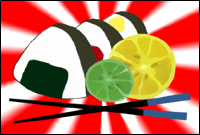Onigiri - Japanese Food on the Go!
Created | Updated Jul 19, 2007

Rice, Seaweed and a Surprise Inside!
Eaten either for lunch, for breakfast, or as a convenient portable snack, Japanese onigiri are a good thing... once you've made peace with the concept, that is. The idea of cold, cooked rice wrapped in dried seaweed may make some of you queasy, and in practice they do take some getting used to. This is perhaps why most foreigners in Japan first go through a stage of making do with Japanese bread instead. However, Japanese bread is not recommended to those who are used to wholewheat North European bread, or French bread for that matter. Japanese bread is thick-sliced, white, fluffy and is remarkable for its complete lack of sustenance altogether. It's not unlike foam plastic.
Back to onigiri. Each one is made of boiled rice, wrapped in a triangular shape in a sheet of dried seaweed or nori (the same stuff they wrap sushi in, only with sushi the seaweed is a roasted variety). As previously stated, the shape of the whole thing is triangular, and when the nori sheet is folded around the body of rice, a sheet of plastic is also folded in with it so as to preserve it nicely. When you take off the plastic, follow the instructions as printed on the thing because if you just start unfolding, you'll unfold the nori with the plastic, and you'll be left with a moist sticky triangle of rice sitting awkwardly between your fingers, as well as drawing some amused looks from any Japanese around you.
Inside onigiri is a filling, which is not rice but some kind of taste-maker. It can be many things: salmon, processed seaweed, soy beans of the fresh, marinated or fermented variety, eggs of tuna or other fish. The Japanese love salty, tangy tastes; they even have a word for a specific kind of taste, which supposedly doesn't feature in foreign cooking, called umami1. Some varieties of filling recipes will surprise you for the better, some for the worse; some will have you running for a rubbish bin. It is generally a good idea to look at the picture printed on the plastic wrapping to see if you can make out what's inside (or read the Japanese if you can). It's also a good idea, when taking a bite, to pair the filling with some rice, as the filling will always have a strong taste when eaten pure.
Onigiri are cheap! They're easy to bring along with you if you're going on a trip, as they're about the size of a doughnut, although they won't keep for very long. Outside the fridge they will go bad, inside, they'll dry out quickly. But they're available in any of the country's ubiquitous convenience stores, and there's enough varieties out there to keep you surprised and satisfied for months on end. All in all, onigiri is one of the better Japanese choices of portable food.

